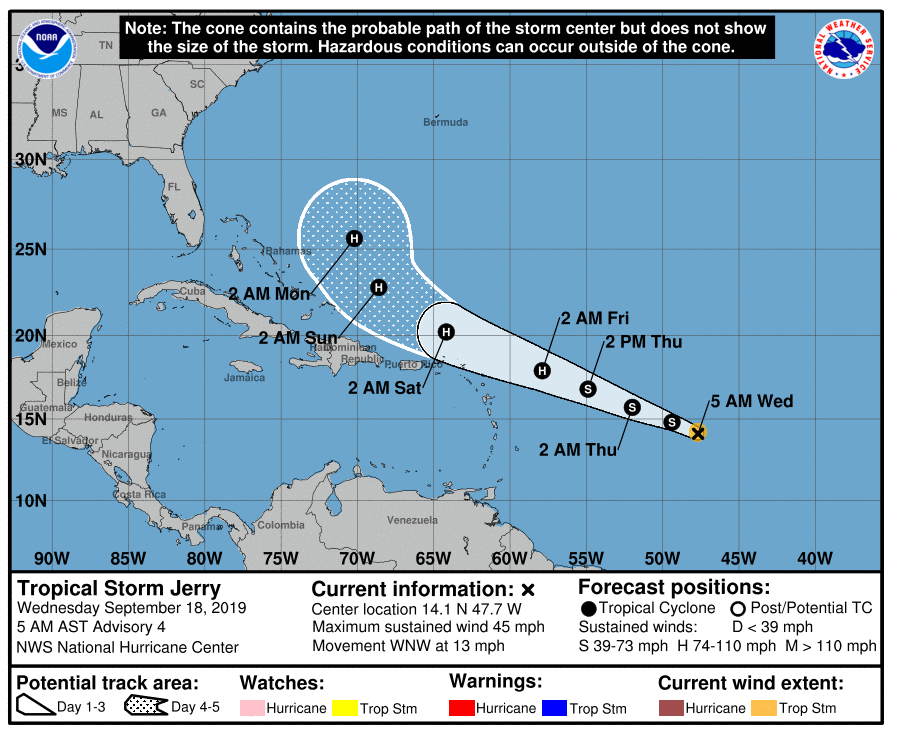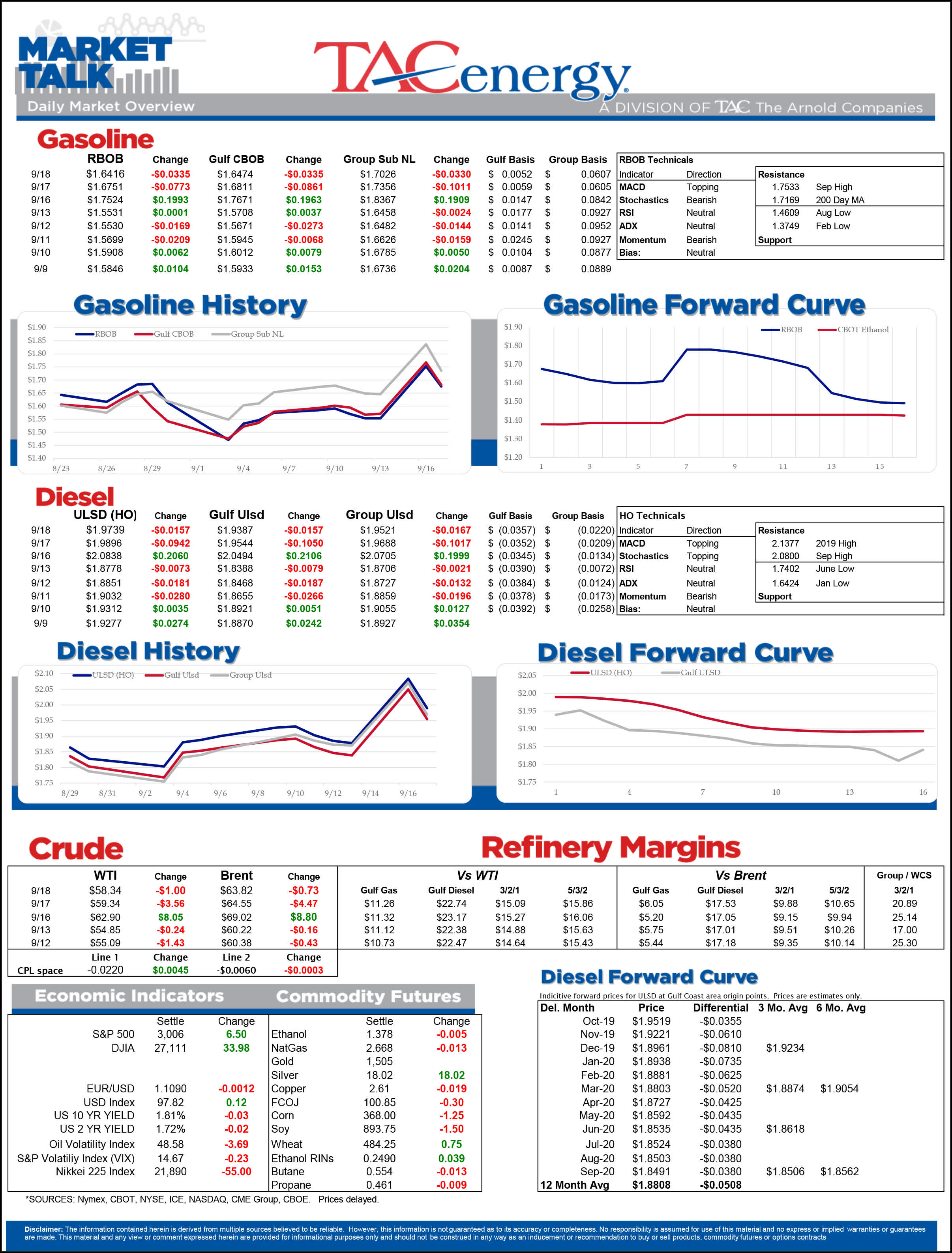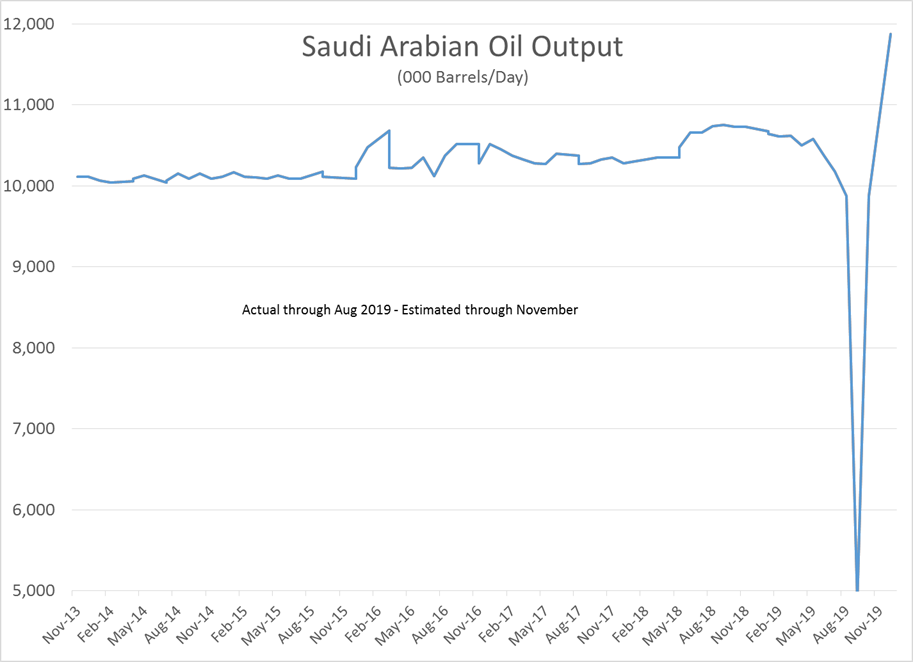Energy Futures Give Back Half Of Monday Gains

Energy futures gave back roughly half of their Monday gains (which were the largest daily increases in more than 10 years) during Tuesday’s session, after Saudi Arabian officials said that half of its output had already been restored, and that the remainder would be back online by the end of the month. In addition, there were reports that the Saudi’s were planning on ramping up production to 12 million barrels/day by November, compared to a self-restricted 9.8 million barrels/day prior to the attacks, which could mean the Kingdom is once again ready to use its oil weapon to teach Iran a lesson.
Whether or not the claims of increasing production to new record highs are even physically possible is a matter that will be hotly debated in the coming weeks. That said, if economic war-far is chosen over conventional methods of retaliation for the weekend attacks, that certainly could be bearish for prices, as the Saudi’s production restraint was seen as the main driver holding up crude oil prices in an oversupplied environment the past few years.
That negative sentiment continued overnight with another wave of selling across the barrel, aided by inventory increases, but perhaps tempered by uncertainty surrounding the FED.
The API was said to show builds across the board, with distillates up 2 million barrels on the weeks, while gasoline stocks increased by 1.6 million barrels and crude oil inventories grew by 592,000 barrels. The DOE’s weekly report is due out at 9:30 central.
FED coin-flip: The CME’s Fedwatch tool shows futures are pricing in close to equal odds of a 25 point rate cut vs no action today, compared to a month ago when another cut was given 100% odds of happening.
Tropical Storm Imelda formed and made landfall near the heart of refining country Tuesday. That storm is bringing flooding to the Houston area, but at this point there are no reports of refinery shutdowns or other supply disruptions. Fortunately it seems we’ve dodged another tropical bullet as that system just didn’t have enough time over open water to develop into a more severe threat. No time to rest however as Tropical Storm Jerry also has formed over the Atlantic and is expected to reach hurricane strength Friday. Most models continue to favor a north-east turn next week that will keep this system at sea, but there is still a potential threat for Florida and the SE that we’ll need to keep an eye on.
Latest Posts
Week 17 - US DOE Inventory Recap
The Energy Complex Is Trading Modestly Lower So Far This Morning With WTI Crude Oil Futures Leading The Way
Energy Futures Are Drifting Quietly Higher This Morning
Refined Products Holding Close To Break Even While Oil Prices Are Losing Just Under 1%
Social Media
News & Views
View All
Week 17 - US DOE Inventory Recap

The Energy Complex Is Trading Modestly Lower So Far This Morning With WTI Crude Oil Futures Leading The Way
The energy complex is trading modestly lower so far this morning with WTI crude oil futures leading the way, exchanging hands $1.50 per barrel lower (-1.9%) than Tuesday’s settlement price. Gasoline and diesel futures are following suit, dropping .0390 and .0280 per gallon, respectively.
A surprise crude oil build (one that doesn’t include any changes to the SPR) as reported by the American Petroleum Institute late Tuesday is taking credit for the bearish trading seen this morning. The Institute estimated an increase in crude inventories of ~5 million barrels and drop in both refined product stocks of 1.5-2.2 million barrels for the week ending April 26. The Department of Energy’s official report is due out at it’s regular time (9:30 CDT) this morning.
The Senate Budget Committee is scheduled to hold a hearing at 9:00 AM EST this morning regarding a years-long probe into climate change messaging from big oil companies. Following a 3-year investigation, Senate and House Democrats released their final report yesterday alleging major oil companies have internally recognized the impacts of fossil fuels on the climate since as far back as the 1960s, while privately lobbying against climate legislation and publicly presenting a narrative that undermines a connection between the two. Whether this will have a tangible effect on policy or is just the latest announcement in an election-yeardeluge is yet to be seen.
Speaking of deluge, another drone attack was launched against Russian infrastructure earlier this morning, causing an explosion and subsequent fire at Rosneft’s Ryazan refinery. While likely a response to the five killed from Russian missile strikes in Odesa and Kharkiv, Kyiv has yet to officially claim responsibility for the attack that successfully struck state infrastructure just 130 miles from Moscow.
The crude oil bears are on a tear this past week, blowing past WTI’s 5 and 10 day moving averages on Monday and opening below it’s 50-day MA this morning. The $80 level is likely a key resistance level, below which the path is open for the American oil benchmark to drop to the $75 level in short order.
Click here to download a PDF of today's TACenergy Market Talk.

Energy Futures Are Drifting Quietly Higher This Morning
Energy futures are drifting quietly higher this morning as a new round of hostage negotiations between Israel and Hamas seem to show relative promise. It seems the market is focusing on the prospect of cooler heads prevailing, rather than the pervasive rocket/drone exchanges, the latest of which took place over Israel’s northern border.
A warmer-than-expected winter depressed diesel demand and, likewise, distillate refinery margins, which has dropped to its lowest level since the beginning of 2022. The ULSD forward curve has shifted into contango (carry) over the past month as traders seek to store their diesel inventories and hope for a pickup in demand, domestic or otherwise.
The DOE announced it had continued rebuilding it’s Strategic Petroleum Reserve this month, noting the addition of 2.3 million barrels of crude so far in April. Depending on what the private sector reported for last week, Wednesday’s DOE report may put current national crude oil inventories (include those of the SPR) above the year’s previous levels, something we haven’t seen since April of 2022, two months after Ukraine war began.
The latest in the Dangote Refinery Saga: Credit stall-out, rising oil prices, and currency exchange.
Click here to download a PDF of today's TACenergy Market Talk.



